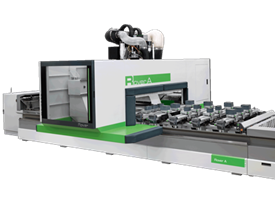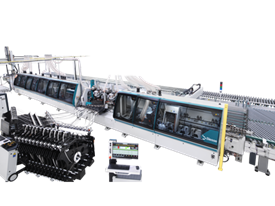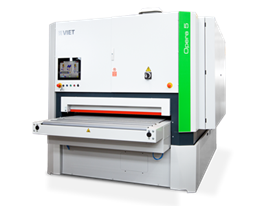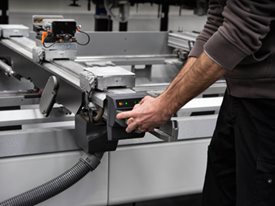To simplify this interesting technique of the woodworking industry, we have created a comprehensive set of questions that will help you understand edge banding like never before! And if you have set foot in the furniture industry for the first time, it will be your digital manual. This blog is aimed to act as a complete guide to resolve all your questions related to what is edge banding, its uses, benefits, limitations, machinery, and much more.
What is Edge Banding
To explain simply, it’s the process of applying thin strips of wood to the raw edges of a piece of furniture. The strips of wood are measured and cut into appropriate sizes so as to exactly fit with the wood panel as if it’s an original part. The edge band acts as a protective layer from moisture and possible warping due to aerial humidity, adding to the strength and durability of the piece. Its purpose is to match the plywood sides with the finished cabinet or furniture for a seamless finish.
What are the Uses of Edge Banding in Woodworking?
Many business owners in furniture manufacturing have this question - what are the uses of edge banding in woodworking? To resolve this, we have listed down the benefits of using an edge bander machine in commercial furniture manufacturing.
- Chipped sides of furniture don’t leave a good impression! The automatic edge banding machine reinforces the sides of the wood to protect it from everyday wear and tear. It protects the sides of your furniture from regular scrapes and knocks that come from the continuous use of cabinets or tables.
- Another benefit of edge banding is its ability to transform the aesthetic of your furniture. When edge bands match with the wood panel in terms of texture & colour, it enhances the value and appeal of the furniture.
- As we discussed at the start, edge bands seal the raw panel edges from moisture to protect them from atmospheric humidity. This extensively improves the durability of the wood.
- If worn or damaged with time, edge bands can be easily replaced which makes them economical. They come in different colours and finishes, offering you the advantage to revamp your furniture.
- It is much more affordable than solid-wood edging which also involves the additional cost of staining or varnish.
Different Materials Used for Edge Banding
Various materials like PVC, wood veneer, and acrylic are used for edge banding. It’s essential to use the right band for a certain kind of wood to ensure its longevity and strength. Mostly PVC edge bands (made with thermoplastic resin) are primarily used to cover modular furniture wood panels.
As PVC strips can be easily replicated to blend in with the exact shade & finish of modern furniture. They are also impervious and flexible to apply on curved wood surfaces.
Veneer edge bands are crafted from pre-sanded real wood slices that are laminated together into a roll. It is comparatively cheaper than PVC edge bands and gives a natural finish whether painted or stained.
Acrylic resin bandings are heat-resistant and superior in durability, which makes them suitable for heavy-duty wooden flooring and kitchen countertops.
Other materials used in edge banding are ABS and Polypropylene. PP edgebanding can withstand extreme heat conditions, making it an excellent option for high-temperature areas. ABS is a versatile thermoplastic commonly used in kitchens because of its ability to withstand cleaning agents.
How to Glue Edge Banding? Understand the Process
There are several other methods of applying edge banding which involves use of manual iron, hot laser, edge banding tape, and laser edging.
- In commercial manufacturing, industrial machines with heat applicators and hot adhesives are used for the automated production of optimum quality furniture.
- A strip of edge band is supplied through an edge bander machine that places it against a wood board.
- A heated roller or hot air gun helps activate the glue at the same time while a pressure roll applies consistent force for a continuous smooth finish.
- During this process, a clamp holds the edge band strongly against the wood panel to keep it securely in place.
- A second roller applies more heat to melt the remaining adhesive after that a blade scrapes off any excess banding from the sides.
- The wood board is buffed before the finished panel is ready.
Different Types of Edge Banding Glue
The edge banding machine glue generally used are PA (Polyamide) and PVA (Poly Vinyl Acetate), these are the most common adhesives for attaching edge bands. These hot-melt glues are quite flexible under high-temperatures making them equally tough and durable in low-temperatures. Their water-resistant property supports the function of an edge band tape.
What is the Ideal Edge Banding Tape Thickness
A variety of thicknesses is used for edge banding wood panels which ideally depends on the furniture and its use. Usually, an edge band of 0.5 mm is used for low-use cabinets and 1 mm thickness is preferred for high-use kitchen and bathroom cabinets. For commercial requirements, a 3 mm edge banding would ensure durability.
How to Fix Edge Banding Tape at Home?
If you are looking to fix a chipped edge banding tape by yourself at home, veneer banding tape would be the easiest to achieve a perfect finish. The only tools you will need for this project are a scalpel or knife and an iron. Follow these steps:
- Hold the tape against the panel.
- Heat the banding with iron while applying pressure with a heavy object.
- Once you reach the panel’s end, cut off the excess band.
- Now scrape the excess edge band from the sides.
- Buff the sides for a smooth finish.
Conclusion
We hope this blog helps you find the answers to all your questions about what is edge banding and its advantages in automating commercial furniture manufacturing. For at-home projects, we have suggested the best edge band that would surely ease your task.
Note that the best edge band can be decided by the type of material used for your furniture. When you have this information, you can choose from a variety of pre-glued, wood, and acrylic edge band tapes.
If you choose the right material and a good edge banding machine, the final product would be lasting and tasteful for modern customers. All edge banding machines come with various features and benefits, it’s important to check your business’ budget and requirements before buying one.



.png)





 Worldwide
Worldwide
 Italia
Italia
 United Kingdom
United Kingdom
 Россия
Россия
 France
France
 中国
中国
 Asia
Asia
 Deutschland
Deutschland
 España
España
 Schweiz
Schweiz
 North America
North America
 India
India
 Australia & New Zealand
Australia & New Zealand
 Türkiye Cumhuriyeti
Türkiye Cumhuriyeti
 Middle East
Middle East
 Brasil
Brasil